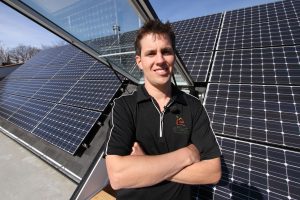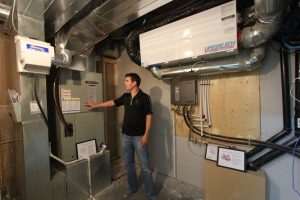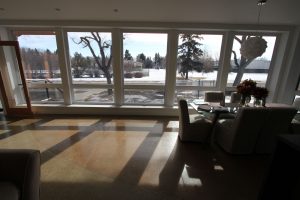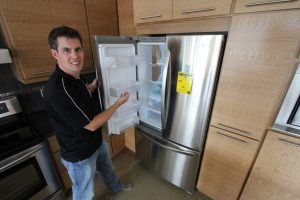By David Dodge and Duncan Kinney
The idea that a home could produce as much energy as it consumes has been a reality for at least five years. Called net-zero homes, cutting edge homebuilders have pushed the envelope and created monuments to efficiency, air-tightness and insulation.
Now comes the slightly less sexy but just as important next step–take the best ideas from the net-zero concept homes and work them into everyday Canadian homes.
Les Wold is a part of this second wave of net-zero

Les Wold, a managing partner with Effect Homes, is part of the second wave of net-zero home builders making it simpler and more affordable.
home builders. A baby-faced 38-year-old he’s a managing partner with Effect Homes, an Edmonton based homebuilder that currently builds about 10 houses a year.
In a rather serendipitous turn of events Les Wold responded to a community newsletter ad from Jeanette Bowman and Kevin Taft when they were looking for two other families to build net zero homes with.
Together they embarked on the Belgravia Green project to build three super energy efficient homes in the mature Edmonton neighbourhood of Belgravia.
Two attractive, modern infill homes now bookend a net-zero show home with a large solar array in the middle and all three feature different heating systems, which brings home the point that there many ways to get to net-zero.

The Belgravia Green net-zero home project by Effect Homes. One net-zero home (middle) and two near net-zero homes were built next to each other.
The big net-zero heating test
While all three homes are airtight and super insulated with R40 foundations and triple pane windows all three homes have different heating systems. This gives Effect Homes the opportunity to see how different heating systems work for future net-zero projects.
All three heating systems have replaced the typical gas-fired furnace. None of these three homes has a gas line connected to it.
House #1: Geothermal heating
Its heating comes from a geothermal heating system that uses a ground source heat pump. It’s easiest to think of this kind of heating system like a reverse refrigerator.
A refrigerator uses a heat pump to pump heat from inside the fridge to outside the fridge to maintain a pleasant fridge-like temperature. A geothermal system uses a heat pump to pump heat from the ground into your house to keep it at a pleasant temperature for humans.
A geothermal system can entirely eliminate your need for a gas line and monthly gas bills. Over the lifetime of the house this can mean substantial savings. Upfront costs are the highest[PE1] but geothermal also offers a second potential major benefit – you can run it in reverse and use it to cool the home as well as heat it.
According to energy expert Gordon Howell you “get the most value out of a geothermal system when you have large air conditioning needs.” In a place like Medicine Hat, Alberta where a building owner can spend as much on cooling as heating for example.
This first home reached an EnerGuide rating of 91 which means the home requires little or no external energy.
House #2: Air source heat pump

Les Wold of Effect Homes shows off the air source heat pump that heats the home. It works like a reverse air conditioner, taking heat from the surround air and pumping it into the home. It’s effective down to -15 degrees.
An air source heat pump is the same as our geothermal system with a major difference. Instead of pumping heat from the ground into the house it pumps the heat from the outside air into the house.
Think of it as a reverse air conditioner. Instead of pumping the warm air out of the house for cooling you’re pumping warm air into the house for warmth. It does this all the way down to minus 15 degrees. After that it uses electric heating to help out on very cold winter days.
This system costs less than geothermal and is fairly new to Alberta. Traditionally they have been only recommended for southern Canada. Installed in the net-zero show home it will provide a lot of interesting data to Effect Homes on the efficiency of this kind of heating system in our climate.
This net-zero show home gets 30 per cent of its heat from its passive solar design – a wall of south facing windows and a very comfortable concrete floor to store the heat.
The mechanical room in this otherwise whizbang home is remarkably empty. The air source heat pump and supplementary electric heaters look like a conventional furnace and then there is an on demand hotwater heater on the wall and a heat recovery ventilator to provide lots of fresh, preheated air to the home.
This home has a pending Energuide rating of 100.
House #3: Baseboard heaters
These are simply electric heaters that are scattered throughout the house. While not the most efficient form of heat, the third house has double stud, R56 walls and an R100 roof which means it does not require much heat.
The building envelope on this home is so solid that all it requires is the body heat of the occupants and some electric heaters scattered throughout the home. This home is solar ready and the owners say it will eventually get its electricity from solar panels.
“It’s very cheap to install. The downside is that the electricity costs are very expensive,” says Howell. This home has an Energuide rating of 90.

Large south facing windows and a thermally massive concrete floor mean a much smaller heating bill.
How to build a net-zero home
While the active heating systems are important according to Wold, the three most important things in building a net-zero home are;
- A high quality building envelope – Windows, doors and air sealing must be top notch
- Passive solar space heating – Orient the house south with lots of windows and interior thermal mass (typically a concrete floor).
- Solar photovoltaic panels to generate electricity
While the two near net-zero homes don’t have solar panels at the moment they are solar-ready. Being solar ready means there is a conduit up to the roof and the roof is engineered to support the weight of a potential solar array. If you’re interested in solar in the future and are doing renovations you should check out the solar ready guidelines from CanSIA.

Les Wold, “It’s inertia that stops everyone from building like this but as they start seeing demand for it they’ll come around.”
Why does he do it?
For Wold, “building a standard home just isn’t as rewarding as trying to push the envelope and build houses in a much more sustainable way. We’re trying to showcase that this is attainable and we can do it now.”
“All three managing partners have children and we are doing it because we truly believe it’s making a difference. We are doing it for future generations, says Wold.
There’s also a bit of a competitive and perfectionist streak in Wold.
“ We want to be the best we can at anything we take on. Building the right kind of home is part of that. We’re eco-geeks too, we love to learn about these new technologies and researching them and exploring new opportunities.”
Net-zero on the upswing
According to Natural Resources Canada a home with an Energuide rating of 86 and above is considered near net-zero. With over 3337 homes rated Energuide 86 and above in that are considered net-zero ready it’s clear that the idea of net-zero homes are here to stay.0
As costs come down on technologies like solar panels it’s not hard to envision a future where every house is a super efficient mini-power plant. With people like Les Wold leading the way and teaching others it could be closer than we think.
“We are being very open about the lessons we’ve learned along the way. We’ve had multiple builders come through our net-zero projects and conducted all kinds of information sharing sessions to try and help other builders to come on board, the more people embracing it the better. We always want to be one step ahead but sharing along the way,” says Wold.

The net-zero showhome built by Effect Homes.






